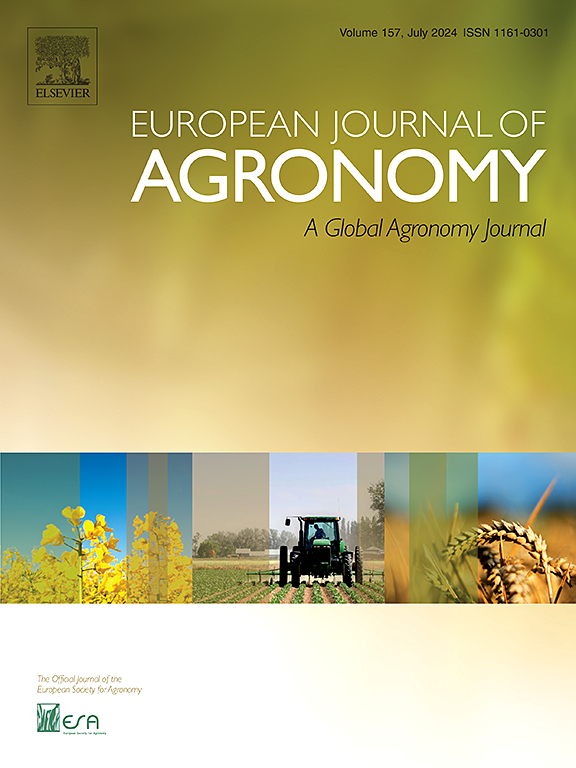不同降维算法对小麦土壤全氮高光谱估测效果的比较分析
IF 4.5
1区 农林科学
Q1 AGRONOMY
引用次数: 0
摘要
土壤氮供应水平对冬小麦的生长发育和产量形成能力有着深远的影响。在目前的农业实践中,氮肥的过度使用对环境和作物生长都有负面影响。因此,利用高光谱遥感技术实时、无损地估算土壤全氮含量,对于推进作物施肥策略和精准农业至关重要。目的(1)探讨不同降维算法对麦田土壤全氮含量高光谱估算的影响。(2)研究了山西晋中地区麦田土壤全氮含量高光谱检测的最优模型。方法综合多种预处理方法,采用主成分分析(PCA)、奇异值分解(SVD)、不相关变量消除(UVE)和随机森林(RF)四种降维算法对数据进行降维。构建了基于支持向量回归(SVR)和反向传播神经网络(BPNN)的土壤全氮含量估算模型,并与梯度增强决策树(GBDT)进行了比较。结果特征提取算法PCA和SVD在对高光谱数据降维时产生相同的主成分和累积贡献。UVE选择的特征波段数量远少于RF选择的特征波段数量。RF选择的特征波段跨越了可见光、近红外和中红外波长范围,而UVE选择的特征波段大多位于可见光波长范围内。PCA降维和SVD降维后的建模结果较为相似,而基于rf选择波段的模型与全光谱波段的模型相比变化不大。采用乘法散射校正(MSC)预处理和SVD降维构建的SVR模型估算土壤全氮含量的精度最高。(Rc2 = 0.87, Rv2 = 0.85;RMSEc = 0.13, RMSEv = 0.14;RPDc = 2.82, RPDv = 2.55;MAEc=0.10, MAEv=0.10)结论降维算法对土壤全氮含量高光谱估算模型的建立具有重要意义。与特征选择算法(UVE和RF)相比,特征提取算法(PCA和SVD)在提高光谱建模精度方面效果更明显。高光谱检测麦田土壤全氮含量的最优估算模型组合为MSC+SVD+SVR。本文章由计算机程序翻译,如有差异,请以英文原文为准。
Comparative analysis of the effects of different dimensionality reduction algorithms on hyperspectral estimation of total nitrogen content in wheat soils
Context
The level of soil nitrogen supply profoundly impacts the growth, development, and yield formation capacity of winter wheat. Excessive use of nitrogen-based fertilizers in current agricultural practices has negative consequences on both the environment and crop growth. Therefore, real-time, non-destructive estimation of soil total nitrogen content using hyperspectral remote sensing technology is crucial for advancing crop fertilization strategies and precision agriculture.
Objectives
(1) Explores the effects of different dimensionality reduction algorithms on hyperspectral estimation of soil total nitrogen content in wheat fields. (2) Investigates the optimal model for hyperspectral detection of total nitrogen content in wheat field soils in the Jinzhong region of Shanxi Province.
Methods
This study integrates various preprocessing methods and applies four dimensionality reduction algorithms—principal component analysis (PCA), singular value decomposition (SVD), unrelated variable elimination (UVE) and random forest (RF)—to reduce the data dimensions. Support vector regression (SVR) and back propagation neural network (BPNN) models for estimating soil total nitrogen content were then constructed and compared with gradient boosted decision tree (GBDT).
Results
The feature extraction algorithms PCA and SVD produced the same principal components and cumulative contributions when reducing the dimensionality of hyperspectral data. The number of characteristic bands selected by UVE was much smaller than that selected by RF. The characteristic bands selected by RF spanned the visible, near-infrared, and mid-infrared wavelength ranges, while those selected by UVE were mostly located within the visible light wavelength range. The modelling results following PCA and SVD dimensionality reduction were relatively similar, while the models based on RF-selected bands showed little change compared to full-spectrum band modeling. The SVR model constructed using multiplicative scatter correction (MSC) preprocessing and SVD dimensionality reduction had the highest accuracy in estimating soil total nitrogen content. (Rc2=0.87, Rv2=0.85; RMSEc=0.13, RMSEv=0.14; RPDc=2.82, RPDv=2.55; MAEc=0.10, MAEv=0.10)
Conclusions
Dimensionality reduction algorithms significantly contribute to the development of hyperspectral estimation models for soil total nitrogen content. The feature extraction algorithm (PCA and SVD) shows more obvious effect in improving the spectral modeling accuracy compared to the feature selection algorithm (UVE and RF). The optimal estimation model combination for hyperspectral detection of total nitrogen content in wheat field soils is MSC+SVD+SVR.
求助全文
通过发布文献求助,成功后即可免费获取论文全文。
去求助
来源期刊

European Journal of Agronomy
农林科学-农艺学
CiteScore
8.30
自引率
7.70%
发文量
187
审稿时长
4.5 months
期刊介绍:
The European Journal of Agronomy, the official journal of the European Society for Agronomy, publishes original research papers reporting experimental and theoretical contributions to field-based agronomy and crop science. The journal will consider research at the field level for agricultural, horticultural and tree crops, that uses comprehensive and explanatory approaches. The EJA covers the following topics:
crop physiology
crop production and management including irrigation, fertilization and soil management
agroclimatology and modelling
plant-soil relationships
crop quality and post-harvest physiology
farming and cropping systems
agroecosystems and the environment
crop-weed interactions and management
organic farming
horticultural crops
papers from the European Society for Agronomy bi-annual meetings
In determining the suitability of submitted articles for publication, particular scrutiny is placed on the degree of novelty and significance of the research and the extent to which it adds to existing knowledge in agronomy.
 求助内容:
求助内容: 应助结果提醒方式:
应助结果提醒方式:


